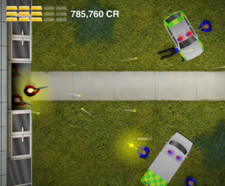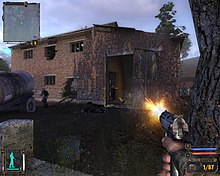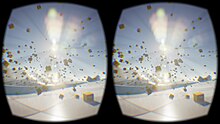Video game graphics
 |
| Part of a series on |
| Video game graphics |
|---|
| Art and video games |
|---|
|
|
A variety of computer graphic techniques have been used to display video game content throughout the history of video games. The predominance of individual techniques have evolved over time, primarily due to hardware advances and restrictions such as the processing power of central or graphics processing units.
Text-based
Some of the earliest video games were text games or text-based games that used
Text games are typically easier to write and require less processing power than
Vector graphics
Vector graphics refer to the use of geometrical
Vector game can also refer to a
Full motion video
Full motion video (FMV) games are
A number of different types of games utilized this format. Some resembled modern
2D
Games utilizing

Top-down perspective
Top-down perspective, also sometimes referred to as bird's-eye view, Overworld, Godview, overhead view, or helicopter view, when used in the context of video games, refers to a camera angle that shows players and the areas around them from above. While not exclusive to video games utilizing parallel projection, it was at one time common among
Side-scrolling game

A side-scrolling game or side-scroller is a video game in which the viewpoint is taken from the side, and the onscreen characters generally can only move, to the left or right. Games of this type make use of scrolling computer display technology, and sometimes parallax scrolling to suggest added depth.
In many games the screen follows the player character such that the player character is always positioned near the center of the screen. In other games the position of the screen will change according to the player character's movement, such that the player character is off-center and more space is shown in front of the character than behind. Sometimes, the screen will scroll not only forward in the speed and direction of the player character's movement, but also backwards to previously visited parts of a stage. In other games or stages, the screen will only scroll forwards, not backwards, so that once a stage has been passed it can no longer be visited. In games such as shoot 'em ups like R-type, the screen scrolls forward by itself at a steady rate, and the player must keep up with the screen, attempting to avoid obstacles and collect things before they pass off screen.
Examples of side-scrolling games include
2.5D, 3/4 perspective, and pseudo-3D
2.5D ("two-and-a-half-dimensional"), 3/4 perspective and pseudo-3D are informal terms used to describe graphical projections and techniques that try to "fake"
These terms sometimes possess a second meaning, wherein the gameplay in an otherwise 3D game is forcibly restricted to a two-dimensional plane.
Examples of games that make use of pseudo-3D techniques include
3D
With the advent of
Voxel engines
Instead of using triangle meshes, voxel engines use voxels.
Fixed 3D
Fixed 3D refers to a three-dimensional representation of the game world where foreground objects (i.e. game characters) are typically rendered in real time against a static background. The principal advantage of this technique is its ability to display a high level of detail on minimal hardware. The main disadvantage is that the player's frame of reference remains fixed at all times, preventing players from examining or moving about the environment from multiple viewpoints.
Backgrounds in fixed 3D games tend to be
Used heavily in the
Further examples include the
Pre-rendered backgrounds are also found in some isometric video games, such as the role-playing game The Temple of Elemental Evil (Troika Games) and the Baldur's Gate series (BioWare); though in these cases the form of graphical projection used is not different.
First-person perspective

First person refers to a
Games with a first-person perspective are usually avatar-based, wherein the game displays what the player's avatar would see with the avatar's own eyes. In many games, players cannot see the avatar's body, though they may be able to see the avatar's weapons or hands. This viewpoint is also frequently used to represent the perspective of a driver within a vehicle, as in flight and racing simulators; and it is common to make use of positional audio, where the volume of ambient sounds varies depending on their position with respect to the player's avatar.[5]
Games with a first-person perspective do not require sophisticated animations for the player's avatar, and do not need to implement a manual or automated camera-control scheme as in third-person perspective.[5] A first person perspective allows for easier aiming, since there is no representation of the avatar to block the player's view. However, the absence of an avatar can make it difficult to master the timing and distances required to jump between platforms, and may cause motion sickness in some players.[5]
Players have come to expect first-person games to accurately scale objects to appropriate sizes. However, key objects such as dropped items or levers may be exaggerated in order to improve their visibility.[5]
Third-person perspective
Third person refers to a
Examples of games utilizing third-person perspective include
Other topics
Stereo graphics
Stereoscopic video games use
Virtual reality headset

The graphics for virtual reality gaming consist of a special kind of stereo 3D graphics to fit the up-close display. The requirements for latency are also higher to reduce the potential for virtual reality sickness.
Multi-monitor setup
Many games can run multi-monitor setups to achieve very high display resolutions. Running games in this way can create a greater sense of immersion, e.g. when playing a video racing game or flight simulator or give a tactical advantage due to the higher field of view.
Augmented reality
Augmented reality games typically use 3D graphics on a single flat screen on a smartphone or tablet, or in a head-mounted display. When playing an AR game on a head-mounted device, the visuals are displayed on transparent glass that overlays the real world and has 3D depth through stereoscopic display.
See also
Technical aspects
- 2D computer graphics
- 3D computer graphics
- Real-time computer graphics
- Rendering
- Image-based modeling and rendering
- Game art design
- Video games
- Computer graphics
- Graphics engine
- 3D rendering
- Game engine
- Sprite
Game genres and gameplay
- Video game genres
- Gameplay
- Graphic adventure games
- Text-based games
References
This article needs additional citations for verification. (August 2010) |
- ^ "7DRL - RogueBasin". Roguebasin.roguelikedevelopment.org. 2011-05-12. Archived from the original on 2011-12-04. Retrieved 2011-11-22.
- ISBN 9780313338687. Retrieved 2011-11-22.
- ISBN 978-4-8053-1659-7.)
{{cite book}}: CS1 maint: others (link - ^ Pedriana, Paul. "Is SimCity 4 3D?". Maxis. Archived from the original on 2009-01-23. Retrieved 2009-01-14.
- ^ a b c d e f g Rollings, Andrew; Ernest Adams (2006). Fundamentals of Game Design. Prentice Hall.
